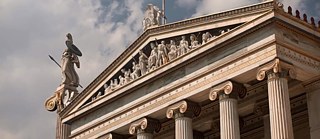The Athens Trilogy
Beauty and symbol

The Athens Trilogy, three buildings in the heart of the Greek capital, is not only a beautiful sight; it is also a symbol of the inspiration of the still-young state of the nineteenth century. A financier from Vienna, a painter from Poland and architects from Denmark and Germany contributed to its creation.
By Nikos Vatopoulos
In the Panepistimiou Street in the heart of Athens stand three neoclassical buildings known as the Athens Trilogy: the Athens Academy, the University and the National Library. These three nineteenth-century buildings, lined up from left to right, are not only among the most beautiful buildings in Greece; they also symbolize the European idea of knowledge and progress. For the Greeks, the Trilogy has a special meaning because the three buildings exude a splendour which, by virtue of the measure of their Greek harmony and general accord, retracts the idea that excesses must submit to the claims of beauty.
This Athenian trilogy is so highly prized by the Greeks because it is a symbol of the ambition with which nineteenth-century Athens, the capital of the young state, strove to be included in the family of the developed Western nations. It embodies the institutional anchoring of the educational ideal and the acceptance of humanist ideas as founding values of this state. The trilogy was created in its present form over a period of about sixty years. This is remarkable, and testifies to how much the young Greek state strained to gird itself institutionally.
One of the most expensive construction projects
The Athens Trilogy also shows that the young Greek state had, after its newly won independence, many benefactors who supported efforts to build a new, modern Greece. Many of them lived outside the borders of the small Greek state of the nineteenth century. For example, Baron Simon von Sina of Vienna financed the construction of the Athens Academy, one of the most expensive construction projects of the time.Tribute to neoclassicism
The Athenian Trilogy was created in the nineteenth century following the Greek revolution against the Ottoman Empire and the subsequent independence of Greece. The buildings represent the fidelity of the new nation to the family of European ideas, including material and spiritual progress and the dissemination of knowledge and research. The architecture of the buildings pays tribute to academic neoclassicism, which had been the national architectural style of Greece since the 1830s. Unlike in other countries, its dominance in Greece surpassed anything before, and the style retained its hold in a multitude of variants, the most interesting of which is that of “folk neoclassicism”, to the beginning of the twentieth century.The chief architects of the Athens Trilogy were the Danish brothers Hansen. Christian Hansen (1803-1883) was the architect of the University of Athens, the first building of the Trilogy, and his brother Theophil (1813-1891) of the Academy and the National Library. Theophil Hansen is one of the highlights of nineteenth-century European architecture, with considerable works also in Vienna, where he undertook the planning of the Trilogy buildings on behalf of Baron Simon von Sina. Through Hansen, the architect Ernst Ziller of Saxony also went to Athens, stayed there and participated in the renewal of the Greek capital after 1880.
A narrative for all Europeans
The Athenian Trilogy remains a unique architectural ensemble to this day. Not only because it embodies the idea of urban beauty and national symbolism, as understood in the nineteenth century, but also because it combines works of art of the highest aesthetic quality, historical value and pan-European significance. It is therefore not only a national monument for the Greeks, but also provides a story that is important for all Europeans.The University of Athens (1839-1864) has a ballroom with neoclassical décor of unique aesthetic perfection. On the outside wall, the visitor can admire the famous frescoes symbolically depicting the first king of Greece, King Otto of Bavaria, in ripe old age and surrounded by female figures that embody, in the spirit of European classicism, the arts and sciences. They were planned by the famous Austrian painter Carl Rahl, financed by Baron Simon von Sina, but only later, in 1888, realized by the Austrian painter Eduard Lebiedzki.
A narrative of European culture
The Academy of Athens is considered one of the most beautiful neoclassical buildings in the world. It is adorned by Ionian columns, on which stand statues of Apollo and Athena, works of the Greek sculptor Leonidas Drosis. Theophil Hansen himself planned the sculptural decoration of the exterior, and under his guidance the famous conference hall of the academy was decorated by the German-Austrian painter Christian Griepenkerl (1839-1916) with a depiction of the myth of Prometheus.The National Library is the third building of the Athens Trilogy. As in the case of the Academy, Ernst Ziller, the pupil and close associate of Theophil Hansen, made here too a decisive contribution. The National Library is dominated by a Doric vestibule and a semi-circular, two-winged exterior staircase, which elegantly relaxes the classical rigour. The facade is inspired by the Temple of Hephaestus in the centre of Athens. Outside the building stands the statue of Panayis Vagliano, one of the Vagliano brothers who financed the construction of the library.
The Athens Trilogy is thus an architectural ensemble that unites within itself the values of European humanism. It belongs both to the history of the Greek nation and to the great narrative of modern European culture.